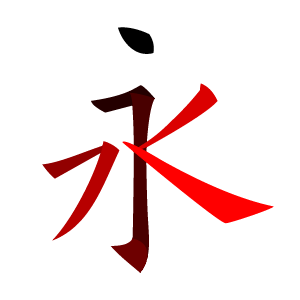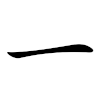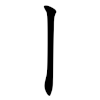Stroke (CJK character)

CJK strokes are the calligraphic strokes needed to write the Chinese characters in regular script used in East Asian calligraphy. CJK strokes are the classified set of line patterns that may be arranged and combined to form Chinese characters (also known as Hanzi) in use in China, Japan, and Korea.
Purpose[]
The study and classification of CJK strokes is used for:
- understanding Chinese character calligraphy – the correct method of writing, shape formation and stroke order required for character legibility;
- understanding stroke changes according to the style that is in use;
- defining stroke naming and counting conventions;
- identifying fundamental components of Han radicals; and
- their use in computing.
Formation[]
When writing Han radicals, a single stroke includes all the motions necessary to produce a given part of a character before lifting the writing instrument from the writing surface; thus, a single stroke may have abrupt changes in direction within the line. For example:
 (Vertical / shù) is classified as a basic stroke because it is a single stroke that forms a line moving in one direction.
(Vertical / shù) is classified as a basic stroke because it is a single stroke that forms a line moving in one direction. (Vertical – Horizontal – Vertical / shù zhé zhé) is classified as a compound stroke because it is a single stroke that forms a line that includes one or more abrupt changes in direction. This example is a sequence of three basic strokes written without lifting the writing instrument such as the ink brush from the writing surface.
(Vertical – Horizontal – Vertical / shù zhé zhé) is classified as a compound stroke because it is a single stroke that forms a line that includes one or more abrupt changes in direction. This example is a sequence of three basic strokes written without lifting the writing instrument such as the ink brush from the writing surface.
Direction[]
All strokes have direction. They are unidirectional and start from one entry point. As such, they are usually not written in the reverse direction by native users. Here are some examples:
Types[]
CJK strokes are an attempt to identify and classify all single-stroke components that can be used to write Han radicals. There are some thirty distinct types of strokes recognized in Chinese characters, some of which are compound strokes made from basic strokes. The compound strokes comprise more than one movement of the writing instrument, and many of these have no agreed-upon name.
Basic strokes[]
A basic stroke is a single calligraphic mark moving in one direction across a writing surface. The following table lists a selection of basic strokes divided into two stroke groups: simple and combining. "Simple strokes" (such as Horizontal / Héng and Dot / Diǎn) can be written alone. "Combining strokes" (such as Zig / Zhé and J hook / Gōu) never occur alone, but must be paired with at least one other stroke forming a compound stroke. Thus, they are not in themselves individual strokes.
| English Name | Name in PRC (pinyin and simp.) |
Name in ROC (pinyin and trad.) |
Name in Japan | CJK stroke |
Meaning of Chinese name (Japanese name, if different) |
Additional description |
|---|---|---|---|---|---|---|
| Simple strokes | ||||||
| Dot | Diǎn, 点 | Diǎn, 點 | Ten, 点 | "Dot" | Tiny dash, speck. | |
| Horizontal | Héng, 横 | Héng, 橫 | Yoko, 横 | "Horizontal" | Rightward stroke. | |
| Vertical | Shù, 竖 | Shù, 豎 | Tate, 豎 | "Vertical" | Downward stroke. | |
| Upward horizontal | Tí, 提 | Tiāo, 挑 | Hane, 跳 | "Rise" ("Jump") |
Flick up and rightwards. | |
| Press | Nà, 捺 | Nà, 捺 | (Migi) Harai, (右)払 | "Press down" ("(Right) Sweep") |
Falling rightwards (fattening at the bottom). | |
| Throw | Piě, 撇 | Piě, 撇 | (Hidari) Harai, (左)払 | "Throw away" ("(Left) Sweep") |
Falling leftwards (with slight curve). | |
| Combining strokes | ||||||
| Zag | Zhé, 折 | Zhé, 折 | Ore, 折 | "Break" | Indicates change in stroke direction, usually 90° turn, going down or going right only. | |
| J hook | Gōu, 钩 | Gōu, 鈎(鉤) | Kagi, 鉤 | "Hook" | Appended to other strokes, suddenly sharp turning before crash stopping. | |
| Clockwise curve | Wān, 弯 | Wān, 彎 | (Hidari) Sori, (左)反 | "Bend" ("(Left) Curve") |
Tapering curved line, usually concave left (convex outward right). | |
| Anticlockwise curve | Xié, 斜 | Qū, 曲 | (Migi) Sori, (右)反 | "Slant" ("(Right) Curve") |
Curved line, usually concave right (convex outward left). | |
Note, the basic stroke Diǎn "Dot" is rarely a real dot. Instead it usually takes the shape of a very small line pointing in one of several directions, and may be long enough to be confused with other strokes.
Compound strokes[]

A compound stroke (also called a complex stroke) is produced when two or more basic strokes are combined in a single stroke written without lifting the writing instrument from the writing surface. The character 永 (pinyin: yǒng) "eternity" described in more detail below demonstrates one of these compound strokes. The centre line is a compound stroke that combines three stroke shapes in a single stroke.
- Basics for making compound strokes[2]
In most cases, concatenating basic strokes together form a compound stroke. For example, Vertical / Shù combined with J hook / Gōu produce ![]() (Vertical – J hook / Shù Gōu). A stroke naming convention sums the names of the basic strokes, in the writing order.
(Vertical – J hook / Shù Gōu). A stroke naming convention sums the names of the basic strokes, in the writing order.
An exception to this applies when a stroke makes a turn of 90° (and only of 90°) in the Simplified Chinese names. Horizontal ![]() (Héng) and Vertical
(Héng) and Vertical ![]() (Shù) strokes are identified only once when they appear as the first stroke of a compound; any single stroke with successive 90° turns down or to the right are indicated by a Zag 折 (pinyin: Zhé) "Break". For example, an initial Shù followed by an abrupt turn right produces
(Shù) strokes are identified only once when they appear as the first stroke of a compound; any single stroke with successive 90° turns down or to the right are indicated by a Zag 折 (pinyin: Zhé) "Break". For example, an initial Shù followed by an abrupt turn right produces ![]() (Shù Zhé). In the same way, an initial Shù followed by an abrupt turn right followed by a second turn down produces
(Shù Zhé). In the same way, an initial Shù followed by an abrupt turn right followed by a second turn down produces ![]() (Shù Zhé Zhé). However, their inherited names are "Vertical – Horizontal" and "Vertical – Horizontal – Vertical". We need not to use "Zag" in the inherited names.
(Shù Zhé Zhé). However, their inherited names are "Vertical – Horizontal" and "Vertical – Horizontal – Vertical". We need not to use "Zag" in the inherited names.
Nearly all complex strokes can be named using this simple scheme.
Nomenclature[]
Organization systems used to describe and differentiate strokes may include the use of roman letters, Chinese characters, numbers, or a combination of these devices. Two methods of organizing CJK strokes are by:
- Classification schemes that describe strokes by a naming convention or by conformity to a taxonomy; and
- Categorization schemes that differentiate strokes by numeric or topical grouping.
In classification schemes, stroke forms are described, assigned a representative character or letterform, and may be arranged in a hierarchy. In categorization schemes, stroke forms are differentiated, sorted and grouped into like categories; categories may be topical, or assigned by a numeric or alpha-numeric nominal number according to a designed numbering scheme.
- Benefits
Organizing strokes into a hierarchy aids a user's understanding by bringing order to an obtuse system of writing that has organically evolved over the period of centuries. In addition, the process of recognizing and describing stroke patterns promotes consistency of stroke formation and usage. When organized by naming convention, classification allows a user to find a stroke quickly in a large stroke collection, makes it easier to detect duplication, and conveys meaning when comparing relationships between strokes. When organized by numbering scheme, categorization aids a user in understanding stroke differences, and makes it easier to make predictions, inferences and decisions about a stroke.
- Limitations
Strokes are described and differentiated using the criteria of visual qualities of a stroke. Because this can require subjective interpretation, CJK strokes cannot be placed into a single definitive classification scheme because stroke types lack a universal consensus on the description and number of basic and compound forms. CJK strokes cannot be placed into a single definitive categorization scheme due to visual ambiguity between strokes, and therefore cannot be segregated into mutually-exclusive groups. Other factors inhibiting organization based on visual criteria is the variation of writing styles, and the changes of appearance that a stroke undergoes within various characters.
Roman letter naming convention of Unicode standard[]
A naming convention is a classification scheme where a controlled vocabulary is used systematically to describe the characteristics of an item. The naming convention for a CJK stroke is derived from the path mark left by the writing instrument. In this instance roman letters are concatenated to form a stroke name is a sequence of one or more roman letters indicating the component strokes used to create the CJK stroke. The first letter of the Han radical’s pinyin pronunciation represents each basic stroke. In a basic stroke example, H represents the stroke ![]() named 横 (pinyin: Héng); in a compound example, HZT represents 横折提 (pinyin: Héng Zhé Tí).
named 横 (pinyin: Héng); in a compound example, HZT represents 横折提 (pinyin: Héng Zhé Tí).
While no consensus exists, there are up to 12 distinct basic strokes that are identified by a unique Han radical.
| Letter | B | D | G | H | N | P | Q | S | T | W | X | Z |
|---|---|---|---|---|---|---|---|---|---|---|---|---|
| Stroke direction | ||||||||||||
| Simp./Trad. | 扁 | 点/點 | 钩/鈎(鉤) | 横/橫 | 捺 | 撇 | 圈 | 竖/豎 | 提 | 弯/彎 | 斜 | 折 |
| Pinyin | Biǎn | Diǎn | Gōu | Héng | Nà | Piě | Quān | Shù | Tí | Wān | Xié | Zhé |
| Meaning | "Flat" | "Dot" | "Hook" | "Horizontal" | "Press down" | "Throw away" | "Circle" | "Vertical" | "Rise" | "Bend" | "Slant" | "Break" |
There are many CJK compound strokes, however there is no consensus for sequence letter naming of compound strokes using the basic strokes. The following table demonstrates the CJK stroke naming convention:
| Stroke | Name in PRC | Abbr[3][4] | Full Name | Dictionary meaning and Note | Example characters | Encoding |
|---|---|---|---|---|---|---|
| 横 | H | Héng | 一 yī, "cardinal number one", "alone" (Radical 1 一). | 二 三 丁 丞 丈 世 不 上 十 卅 七 | U+31D0 (㇐) | |
| 提 | T | Tí | 冰 淋 病 孑 治 冶 冽 暴 氾 录 地 虫 | U+31C0 (㇀) | ||
| 横钩 | HG | Héng Gōu | 乛 wān, ya, zhé (折) turning stroke / to break (Radical: Variant form of 乙 yǐ). | 疋 了 危 予 矛 子 字 令 疏 写 冖 | U+31D6 (㇖) | |
| 横撇 | HP | Héng Piě | 又 水 夕 径 炙 双 叒 今 | U+31C7 (㇇) | ||
| 横折 | HZ | Héng Zhé | 口 囗 己 田 品 吕 申 甲 圆 巪 | U+31D5 (㇕) | ||
| 横折钩 | HZG | Héng Zhé Gōu | (Radical: Variant form of 乙 yǐ). | 羽 习 包 勻 葡 用 青 甫 勺 月 也 乜 | U+31C6 (㇆) | |
| 横折提 | HZT | Héng Zhé Tí | 讠 计 鳩 | U+31CA (㇊) | ||
| 横折折 | HZZ | Héng Zhé Zhé | 凹 | U+31C5 (㇅) | ||
| 横折弯 | HZW | Héng Zhé Wān | 殳 投 朵 | U+31CD (㇍) | ||
| 横折弯钩[3] (横斜钩[4]) |
HZWG[3] (HXG[4]) |
Héng Zhé Wān Gōu[3] (Héng Xié Gōu[4]) |
Unofficial name "HWG" is used by Hugo Lopez.[1] | 飞 风 瘋 凬 虱 迅 气 九 几 | U+31C8 (㇈) | |
| 横斜弯钩[3] (横折弯钩[4]) |
HXWG[3] (HZWG[4]) |
Héng Xié Wān Gōu[3] (Héng Zhé Wān Gōu[4]) |
乙 yǐ, niè, "the second of the ten heavenly stems", "second"; zhé (折) turning stroke / to break (Radical 5 乙). | 氹 乞 乤 艺 | U+31E0 (㇠) | |
| 横折折折 | HZZZ | Héng Zhé Zhé Zhé | 凸 | U+31CE (㇎) | ||
| 横折折撇 | HZZP | Héng Zhé Zhé Piě | 建 及 | U+31CB (㇋) | ||
| 横撇弯钩 | HPWG | Héng Piě Wān Gōu | 阝 队 邮 | U+31CC (㇌) | ||
| 横折折折钩 | HZZZG | Héng Zhé Zhé Zhé Gōu | WIKI |






